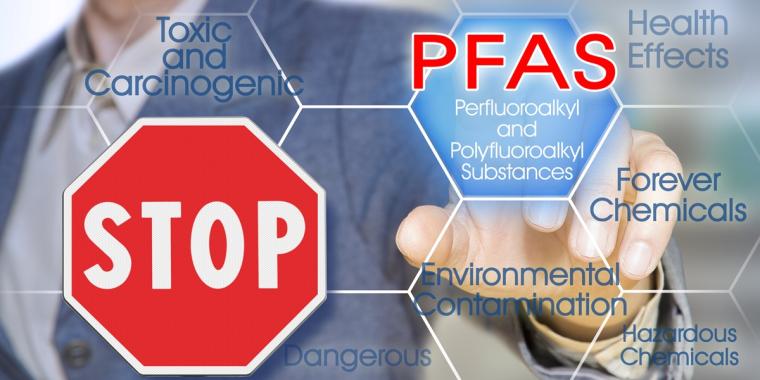
It might have slipped under your radar. It did not slip under the government’s radar or the radar of manufacturers. The U.S. Environmental Protection Agency (EPA) announced the latest efforts to lower the health risks posed by certain per- and polyfluoroalkyl substances (PFAS), a classification of chemicals found in everything from sportswear to soil.
PFAS are known as “forever chemicals” because unlike many substances, they either do not degrade over time, or else they degrade so slowly that their presence continues to be felt for years to come.
According to the Sports and Fitness Industry Association, “There is a growing patchwork of laws that companies must comply with, including a significant cross-over with California’s Prop. 65. Additionally, even products and raw materials that claim to be PFAS-free may actually contain PFAS, especially in light of the varying and increasingly inclusive definitions of the term, PFAS."
Scientific studies show that some PFAS exposure is linked to harmful health effects. EPA is proposing two rules that would add to the agency’s comprehensive approach to tackling PFAS pollution across the country.
Many North America-based companies are heeding the EPA’s stance and are phasing PFAS out of their manufacturing process; unfortunately, the EPA’s information cannot affect products manufactured overseas. And a parent, for example, seeking a brand-name shoe, backpack or anything else needed by a child for a sports event, may well buy from an online site where less expensive products are available from retailers outside the USA.
Here is what we do know about PFAS as it concerns the intersection of sports and business. Some of these may affect decision-making of event owners, while others are simply “good to know” facts.
 Sportswear and Uniforms: PFAS have long been used in everything from goalie gloves to uniforms to socks to many other products worn by adults and children alike. Manufacturers in the USA, seeing the writing on the wall, are moving to remove substances from their products.
Sportswear and Uniforms: PFAS have long been used in everything from goalie gloves to uniforms to socks to many other products worn by adults and children alike. Manufacturers in the USA, seeing the writing on the wall, are moving to remove substances from their products.
Sporting Goods Business, for example, noted, “Liberated Brands announced that starting with Spyder Skiwear’s Fall 20204 season, it will be free of PFAS. With this initiative, the company said it will also introduce innovations in waterproof materials and Durable Water Repellent (DWR) treatments, joining other footwear and apparel companies rushing to meet new PFAS rules and regulations. (Liberated’s portfolio of brands includes Volcom, Billabong, Quiksilver, Spyder, RVCA, Roxy, Honolua, and Captain Fin.)
Toxic-Free Future added, “Patagonia has pledged to eliminate all PFAS across its entire product line by 2024. In July 2022, Columbia committed to a goal of phasing out PFAS by the end of 2024. In 2021, Polartec announced it was eliminating PFAS in its DWR (durable water repellent) treatments across its line of performance fabrics.”
REI also committed to banning PFAS in textiles.
Backpacks: The bags that youth athletes carry are a prime, well, carrier of PFAS. In May 2023, the Ecological Alliance consumer group brought a lawsuit against Nike, after laboratory analysis of an Air Jordan duffle bag found its water-resistant coating contained PFAS. The group sued Nike because the bag did not carry a warning about the presence of PFAS, as required by the California Health and Safety code.
What About Shoes? As mentioned previously, manufacturers in the USA have been working to remove PFAS from products; however, shoes made outside the USA (generally purchased through large online e-tailers like Amazon) and costing less than those found in stores stateside may still contain them.
In May 2023, multiple outdoor companies began phasing out the use of PFAS in products, particularly those with water-repellant or water-resistant properties. Outdoor manufacturer KEEN, for example, discovered its products contained PFAS in 2014 and began addressing the issue.
“The company started by asking suppliers to stop using unnecessary PFAS, which removed about 65 percent of this type of chemicals in their products,” noted Environmental Health News. “It took four years for KEEN to phase out PFAS in all products, through finding and testing chemical water-proofing alternatives.”
Synthetic Turf: As of January 1, 2024, synthetic turf manufacturers in the United States have committed to having synthetic turf be 100 percent free of PFAS. Previously, some manufacturers did use PFAS as an extrusion agent in synthetic turf; however, the PFAS used was not identified as “a PFAS of concern.” In fact, more PFAS of concern may be found in natural soil.
Soil: Environmental releases from manufacturing facilities that use PFAS are the main causes of contamination in soil, including in sports fields. Air emissions, spills and waste can impact the soil (and water, as seen next) at release points and surrounding areas.
Water: Yes, PFAS is found in water. Different offices within the EPA have published methods to test for certain PFAS in drinking water and in non-potable water and continues to work on methods for other matrices. Multiple test methods have been developed as the result of the efforts of the Clean Water Act Methods Program; they can be found in detail here. In brief, they are Method 1633 for 40 PFAS Compounds, and Method 1621 for Adsorbable Organic Fluorine. The EPA notes:
Method 1633 is a test for 40 PFAS compounds in wastewater, surface water, groundwater, soil, biosolids, sediment, landfill leachate, and fish tissue. This method can be used in various applications, including National Pollutant Discharge Elimination System (NPDES) permits. Method 1621 measures the aggregate concentration of organofluorines (molecules with a carbon-fluorine bond) in wastewater. The most common sources of organofluorines are PFAS and non-PFAS fluorinated compounds such as pesticides and pharmaceuticals. (Note that pesticides include those used in backyards as well as sports fields.)
The American Sportfishing Association has noted that it is staying on top of developments that may affect anglers.
This is a developing issue; SDM will provide updates as they are available.

